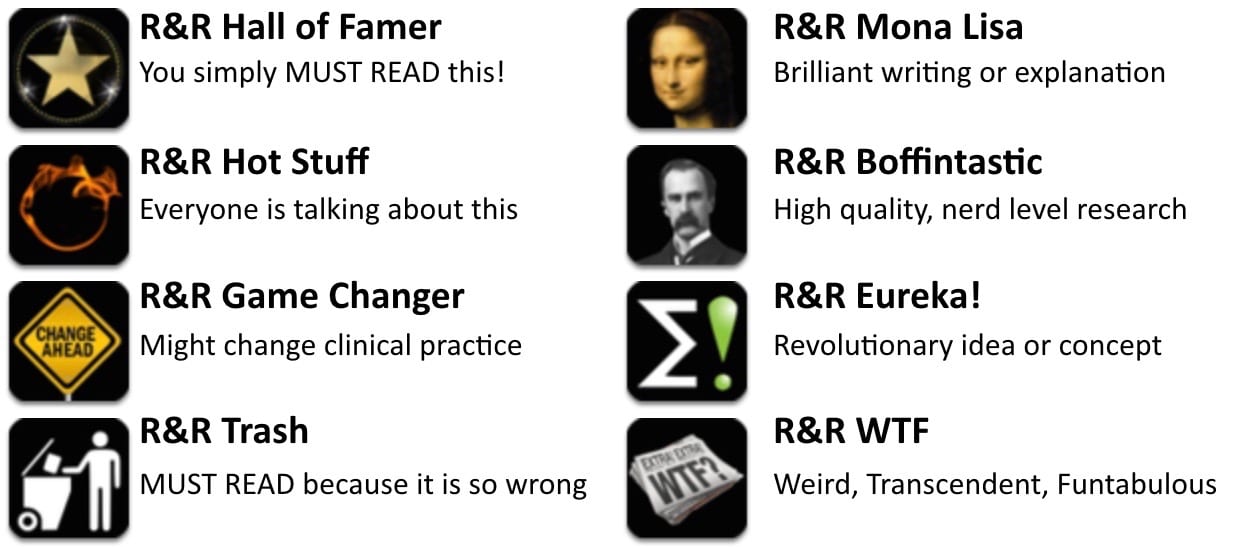R&R In The FASTLANE 038
Welcome to the 38th edition of Research and Reviews in the Fastlane. R&R in the Fastlane is a free resource that harnesses the power of social media to allow some of the best and brightest emergency medicine and critical care clinicians from all over the world tell us what they think is worth reading from the published literature.
This edition contains 10 recommended reads. The R&R Editorial Team includes Jeremy Fried, Nudrat Rashid, Soren Rudolph, Anand Swaminathan and, of course, Chris Nickson. Find more R&R in the Fastlane reviews in the : Overview; Archives and Contributors
This Edition’s R&R Hall of Famer
Dying with Dignity in the Intensive Care Unit. Deborah Cook, M.D., and Graeme Rocker, D.M. N Engl J Med 2014; 370:2506-2514 June 26, 2014. PMID: 24963569
- An excellent reviews article on a problem we are faced with daily. The article is rife with useful mnemonics e.g. ABCD’s of dignity conserving care (attitudes, behaviors, compassion, and dialogue) and tables which advise on how to take a spiritual history, how to prepare practically prior to withdrawal of life support. To deliver excellent end of life care is now an essential part of intensive care medicine. This is a must read!
- Recommended by: Nudrat Rashid
Leacock BW. Double simultaneous defibrillators for refractory ventricular fibrillation. J Emerg Med. 2014 Apr;46(4):472-4. doi:10.1016/j.jemermed.2013.09.022. Epub 2014 Jan 21. PMID: 24462025
- Next time you have refractory VF case, this may be worth a try. Interesting case report. Doubling the defibrillators being used is pretty high powered stuff.
- Recommended by: Jeremy Fried
Endovascular treatment for acute ischemic stroke. Ciccone A et al; SYNTHESIS Expansion Investigators. N Engl J Med. 2013 Mar 7;368(10):904-13. doi: 10.1056/NEJMoa1213701. PMID: 23387822
- This paper attempted to show that endovascular treatment of stroke is superior to thrombolysis in acute ischemic stroke, in the same way PCI has been proven superior for myocardial infarction. They instead found no significant difference in their primary outcome, survival free of disability, while the rate of ICH was the same in both groups. Good study design with a good primary outcome, but the bottom line is strokes are not heart attacks and endovascular treatment is not universally better.
- Recommended by: Zack Repanshek
Korinek JD et al. Comparison of rocuronium and succinylcholine on postintubation sedative and analgesic dosing in the emergency department. Eur J Emerg Med 2014; 21(3):206-11. PMID: 23510899
- This retrospective study found that patients given rocuronium during RSI (in comparison to succinycholine) received lower doses of sedatives (mainly propofol) and analgesics (mainly fentanyl) post-intubation. The study reminds us that patients must be properly treated with analgesics and sedatives after intubation but the design does not allow it to show that rocuronium use was the cause of lower post-intubation sedation medication use or that the patients in the rocuronium group were undersedated at all (no assessment of sedation status).
- Recommended by: Anand Swaminathan
Murthi SG et al. Effectiveness of neuraminidase inhibitors in reducing mortality in patients admitted to hospital with influenza A H1N1pdm09 virus infection: a meta-analysis of individual participant data. Lancet Respir Med 2014; 2: 395-404. PMID: 24815805
- In this observational cohort of 29,000 patients treated for influenza, the researchers found an association with decreased mortality (adjusted OR = 0.81) and an additional benefit to early (< 2 days) treatment versus later treatment (adjusted OR = 0.48). This study, however, has major flaws and biases that question the validity of their conclusions. Only 19% of centers that were contacted agreed to contribute data to the Consortium. Additionally, the researchers do not assess the quality of the studies included in their meta-analysis. Regardless, observational data should not be used to trump the RCT data included in the recent, Cochrane review. Finally, Roche pharmaceuticals was a major sponsor of this research team. The accompanying editorial is a must-read.
- Recommended by: Anand Swaminathan
D’Egidio G et al. A study of the efficacy of flashing lights to increase the salience of alcohol-gel dispensers for improving hand hygiene compliance. Am J Infect Control. 2014 Jun 25. PMID: 24974338
- Hand Hygiene rates doubled with the use of a simple inexpensive flashing red light placed next to the alcohol gel dispenser at the main entrance of the hospital. This was thought to be due to the fact that attention of individuals was drawn to the dispenser, however on cold days compliance was worse presumably due to reluctance of individuals to remove their gloves.
- Recommended by: Nudrat Rashid
Nakamura S et al. Impact of the efficacy of thrombolytic therapy on the mortality of patients with acute submassive pulmonary embolism: a meta-analysis. J Thromb Haemost. 2014 May 15. doi: 10.1111/jth.12608. PMID: 24829097
- This is the second meta-analysis on thrombolytics for pulmonary embolism published in the last month. Unlike the prior publication this analysis found no statistical mortality benefit in giving thrombolytics and heparin compared to heparin alone. Interestingly, compared to the previous meta-analysis this one included far fewer studies in their final analysis and though the absolute difference in mortality was similar ( ARR of 1.27% vs. 1.4%) in this case it failed to reach statistical significance because of the decreased power the smaller sample size provided.
- Recommended by: Rory Spiegel, Anand Swaminathan
Teschendorf P, Bernhard M. A bridge to life: ECPR who, when, where and why? Resuscitation. 2014 Jun;85(6):709-10. PMID: 24844727
- As we move forward in our resuscitation practice and consider the incorporation of ECPR into practice, this editorial provides excellent perspective on the limitations of our current state of knowledge, and calls for more research into it’s benefit. Importantly, the authors also emphasize the differences in survival rate for OHCA in different geographic areas, calling for an optimization of known best practice. Optimizing current care has demonstrated a survival rate with good neurological outcome in 25-30% of patients, reminding us, as Mel Herbert says that “what you do matters”.
- Recommended by: Jeremy Fried
Hawkins SC, Weil C, Baty F, Fitzpatrick D, Rowell B. Retrieval of additional epinephrine from auto-injectors. Wilderness Environ Med. 2013 Dec;24(4):434-44. PMID: 24041621.
- Epinephrine auto-injectors are designed to deliver a single dose to a patient in emergent need of the drug. However, on prolonged wilderness trips or while waiting for medical care, a repeat dose may be needed. This article discusses macgyvering auto-injectors when you need a second dose (or more).
- Recommended by: Justin Hensley
Biondo S et al. Outpatient versus hospitalization management for uncomplicated diverticulitis: a prospective, multicenter randomized clinical trial (DIVER Trial). Ann Surg. 2014 Jan;259(1):38-44. PMID: 23732265
- The DIVER trial is a prospective randomized clinical control trial validating what we already do in common clinical practice in sending home uncomplicated diverticulitis. 132 individuals underwent randomization in a 1:1 fashion to either inpatient treatment with parenteral antibiotics or sent home on oral antibiotics. Patients had to be uncomplicated (radiographically defined + symptoms relief, no abscess, no breastfeeding or pregnancy, no cognitive/social impairment, no persistent vomiting, no previous abx usage for diverticulitis) in order to meet inclusion criteria. The primary outcome was treatment failure rates whereas the secondary outcomes were quality of life measures. At the end of the study there were no differences between the two groups. The stud confirms that our current practice of not admitting uncomplicated diverticulitis presuming the patient has good outpatient follow-up is a safe and cost-effective practice. Interestingly the antibiotic of choice for outpatients was Augmentin alone as opposed to the reflexively given dual therapy (cipro/flagyl) that many choose to use.
- Recommended by: William Paolo
Intensivist and Donation Medical Specialist, Australia | @NudratRashid |








